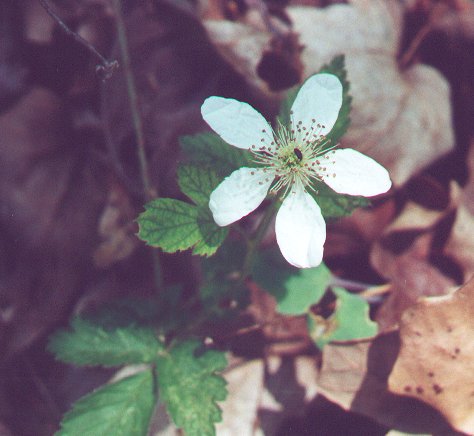Rubus flagellaris Willd.
Northern Dewberry

Native
CC = 3
CW = 3
MOC = 33
© DETenaglia
Rubus flagellaris Willd.Northern Dewberry | |
 |
Native CC = 3 CW = 3 MOC = 33 |
© DETenaglia |
|
Family - Rosaceae Stems - Trailing, with few hooked or straight prickles to +/-1.5mm long, otherwise glabrous, thin, terete. Leaves - Appearing to rise from the sides of the stem, alternate, trifoliolate, petiolate, stipulate. Petioles to +/-3cm long, with few retrorse prickles, lanate, with single longitudinal dorsal groove. Stipules +/-1cm long, +/-5mm broad, entire or with a few coarse teeth, glabrous or sparse pubescent above, lanate below, margins ciliate. Leaflets 3. Lateral leaflets coarsely serrate, oblique at base, sessile, with sparse pubescence above, pubescent below. Terminal leaflet with stalk to 6mm long, broadest at or above the middle, base cuneate, sparse pubescent above, pubescent below, obovate to oblanceolate, coarse serrate.
Inflorescence - Terminal, few-flowered loose cymes. Pedicels to +/-4cm long, lanate. Flowers - Petals 5, white, glabrous, distinct, spreading, to +/-2cm long, +/-1cm broad, obtuse at apex. Stamens many(+75). Filaments to +6mm long, white, glabrous. Carpels many. Hypanthium short, 1-1.5mm long, densely lanate. Sepals 5, narrowly ovate, green with whitish margins, densely lanate internally, lanate externally, subequal, to +6mm long, 3.5mm broad, apiculate, spreading to reflexed.
Flowering - April - June. Habitat - Rocky open woods, rocky slopes, thickets, fields, roadsides, railroads. Origin - Native to U.S. Other info. - This is just one of the 16 or so blackberries found in this state. All produce the familiar black aggregate fruit we love to eat. Most plants in the genus are difficult to tell apart but these trailing species are a bit easier. Photographs taken in the Hercules Glade Wilderness, Mark Twain National Forest, Taney County, MO., 4-28-00. |